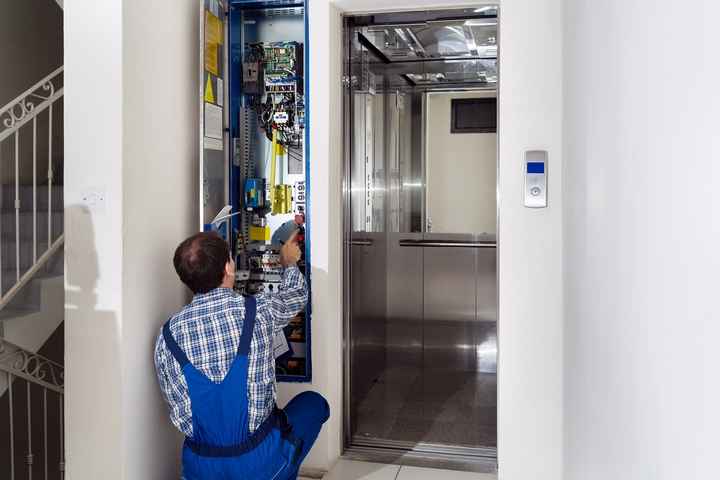Interested In Getting Free Quotes For Your New Home Lift? Click here!
Home lifts are starting to become a more popular option for many people in Australia. They are the perfect mobility tools, and interestingly, they can also be quite affordable.
In this article, we’ll examine the prices of different types of home lifts, as well as a few other important things you would want to keep in mind before installing them.
What Is The Price For A Home Lift In Australia?
Home lift prices in Australia typically range from $35,000 to $65,000 for the lift unit and installation alone, excluding additional costs like building works and remodelling.
The total price depends on factors such as lift type, travel distance, safety features, and whether you’re installing in a new build or retrofitting into an existing home.
Other guides may quote $30,000 to $50,000 for a home lift, but this often overlooks extra building expenses.
Our analysis shows that 60%–70% of inquiries are for retrofitting lifts, which usually requires additional work like updating plumbing, the electricals, or removing walls.
As a result, the total cost for retrofitting a home lift is generally between $60,000 and $100,000 AUD + GST, including installation and construction.
When budgeting, be sure to consider all costs and request all-inclusive quotes from suppliers to get a clear picture. Our service at Lifts For Homes can help you compare up to three comprehensive quotes from top installers in Australia.
Home Lift Pricing Factors In Australia

Several key factors influence the price of a residential lift solution, including:
Lift Size
Generally, larger lifts cost more.
Bigger lifts are often chosen by large families or those with multi-level homes, as they carry more people at once and are useful in emergencies. However, they also require more space, so you’ll need to check if your home can accommodate a larger lift.
Consider whether the lift needs to transport mobility aids like wheelchairs or scooters, as this may require a larger, more expensive model - an important consideration for those with mobility needs.
Number Of Floors To Travel
The more floors the lift needs to reach, the higher the cost.
It is also important to note that more affordable models like through-floor home lifts are only able to travel between 2 floors (typically ground and first).
Any building with more than two floors will typically need to consider enclosed platform lifts or traditional home elevators with a shaft.
Safety & Security Features
Modern home lifts include many safety and security features, some required and some optional.
Mandatory features include door interlocks, emergency stop buttons, and battery backups, which are standard in most models.
Optional features like emergency lighting, key locks, and security cameras are available on some models for an extra cost.
Installation Location (Indoors vs Outdoors)
The location of your home lift, whether indoors or outdoors, can significantly impact the overall cost.
- Indoor installations are the most common and typically more straightforward, as they are better protected from weather and often easier to integrate with your home’s existing structure.
- Outdoor lifts may be necessary if there is limited space inside the home, but these generally require additional weatherproofing, insulation, and structural supports to withstand the elements. This can increase both the initial installation cost and ongoing maintenance expenses. It is also important to note that more lightweight, cost effective models like through-floors lifts are not able to be installed externally. If you have the option, our team would generally recommend placing your lift indoors when possible.
Retrofitting an outdoor lift may also involve more complex planning approvals or compliance with local building codes, which can add to the project timeline and budget.
Midfloor Material Considerations
The material of your home’s midfloors (the floors between levels) is another key cost factor, especially when retrofitting a lift.
-
Timber midfloors are the standard in many Australian homes and are generally easier and less expensive to modify for lift installation. Cutting through timber to create a lift shaft or pass-through is typically straightforward for installers.
-
Concrete midfloors, on the other hand, are much more challenging and costly to work with. Cutting through concrete requires specialised equipment, additional labour, and may necessitate extra engineering to maintain the structural integrity of the building. As a result, installing a lift, especially as a retrofit, into a home with concrete midfloors can add substantial cost and time to your project.
If you’re unsure about your midfloor material, consult with your lift supplier or builder early in the process to get an accurate estimate and avoid unexpected expenses.
Lift Drive Types
There are a number of different drive types available across Australia in the residential sectors, with the main 3, Electric, Hydraulic, and Pneumatic, outlined below. Each of these have different pros and cons, as well as different impacts on the final cost of a project.
-
Electric Home Lifts are among one of the most common models across Australia and can be found in both 2-story and high rise homes. They typically have a smoother and quieter ride than a hydraulic lift. Electrical lifts typically have a slightly higher base price compared to their hydraulic counterparts, which are typically better suited for cost-conscious projects.
-
Hydraulic Home Lifts are also another great option to consider and are a very proven drive type in the residential sector. As they are typically better equip for home with less than 4 stories, hydraulic lifts are often some of the most affordable models available on the market, while still proving to be very reliable and comfortable to ride in. Unlike electric lifts, which house their internals within the shaft or head unit, hydraulics lifts typically have to store their running gear externally in dedicated spaces (machine rooms) or in small boxes next to the lift, which adds to the required space and can be an eye-sore for owners.
-
Pneumatic Home Lifts (also known as vacuum lifts) are a newer drive type available within the sector. They use pressurised air to raise and lower the lift cabin and can be quite suitable for installation in smaller spaces or voids due to their small footprint and circular shape. Due to only being available for a small number of suppliers, and the fact that they typically have a more modern design, they can be quite expensive compared to the other drive types we mentioned.
Compact Home Lifts Price Australia
The price of a Compact Home Lift in Australia is approximately $30,000.
The above price is related to their base model, the Compact Home Lifts Elegance. Compact Home Lifts also offer another 2 slightly different models, each serving their own purpose which also comes with different price points.
Compact Home Lifts Elegance Plus: The Elegance Plus by Compact Home Lifts is their Primary Wheelchair Lift Model. This lift is ideal for those that use wheelchairs or other mobility aids such as a walking frame. The main difference between the Elegance & Elegance Plus models is that the Elegance Plus has a considerably wider footprint and platform, allowing those who use a wheelchair or walker to operate the lift. Because of this, the Elegance Plus model price is closer to $35,000 installed.
Compact Home Lifts Elegance Plus Thru-Car: The Elegance Plus Thru-Car model is essentially the same as the Elegance Plus, however, access to the lift & lift platform is possible from both the front and back of the lift rather than just the front on the Elegance Plus model. This model is ideal for installation in stairwell voids or split-level homes, offering an access solution to those that require further mobility assistance, whilst still maximising your living space. Because of this, the Elegance Plus Thru-Car model price is closer to $35,000 installed.
Lift Installation Cost

Though the installation of a home lift is generally always the responsibility of the company that you bought the lift unit from, this isn’t always the case.
Sometimes, lift units will be purchased from companies based the countries like China, which might not have an installation team here in Australia. This means that a separate lift company must be engaged to undergo the installation process. There are also other reasons why this may happen including moving a lift from your previous home and having it reinstalled after you move to your new house, buying a home lift second-hand, and more.
On average, the installation cost of a home lift in a new build should cost between $4,000 - $8,000.
However, the installation cost of retrofitting a residential elevator into an existing home could cost anywhere from $12,000 to $40,000. This is due to the building costs and structural changes required to make this a reality.
The exact cost will vary based on several factors, including, but not limited to:
- Size and load duty: Residential lifts range from small options (measuring 600x600 mm) and large options (measuring 1,100x1,400 mm). They also have different load capacities. Lifts with higher load capacities will cost more since they’d need larger motors and more engineering requirements.
- Travel distance: Lifts that will be required to travel more than the average distance (between 2.7m and 4.5m) will come with higher price tags.
- Design: Residential lifts come in an array of design features and specifications. The more unique features you need, the higher your bill.
FAQs
What Type Of Lift Is Best For My Home?
This will depend on several factors - including the amount of available space, how much noise you’re willing to accept, and the number of floors you’d like the lift to cover.
How Much Space Do You Need For A Home Lift?
While the requirements differ from house to house, you should have at least 6 square metres of space available if you hope to install a home lift.
How Safe Are Home Lifts?
Home lifts come with different types of security features, and they also adhere to strict building standards that dictate things like weight limits. As long as the lift is installed right, you should be safe.
Your Home Lift, Your Choice: Get & Compare Up To 3 Quotes From Professional Lift Installers To Save Time & Money. It’s Free!

